ACCT2005 Module 4 Report: Financial Statement Analysis of Bayer AG
VerifiedAdded on 2022/09/14
|6
|983
|19
Report
AI Summary
This report presents a financial statement analysis of Bayer AG, a pharmaceutical company, focusing on key ratios to evaluate its performance in 2019. The analysis covers operational management, investment management, financing strategy, and dividend policies. The report calculates and interprets ratios such as operating profit margin, interest coverage ratio, total asset turnover, debt-to-equity ratio, and dividend payout ratio. It also discusses the company's long-term business strategies, including expansion in organic pharmaceuticals and investments in research and development, along with its financial policies aimed at reducing net debt. The analysis provides insights into Bayer AG's efficiency, risk management, and dividend policies, offering a comprehensive overview of its financial health and strategic direction.
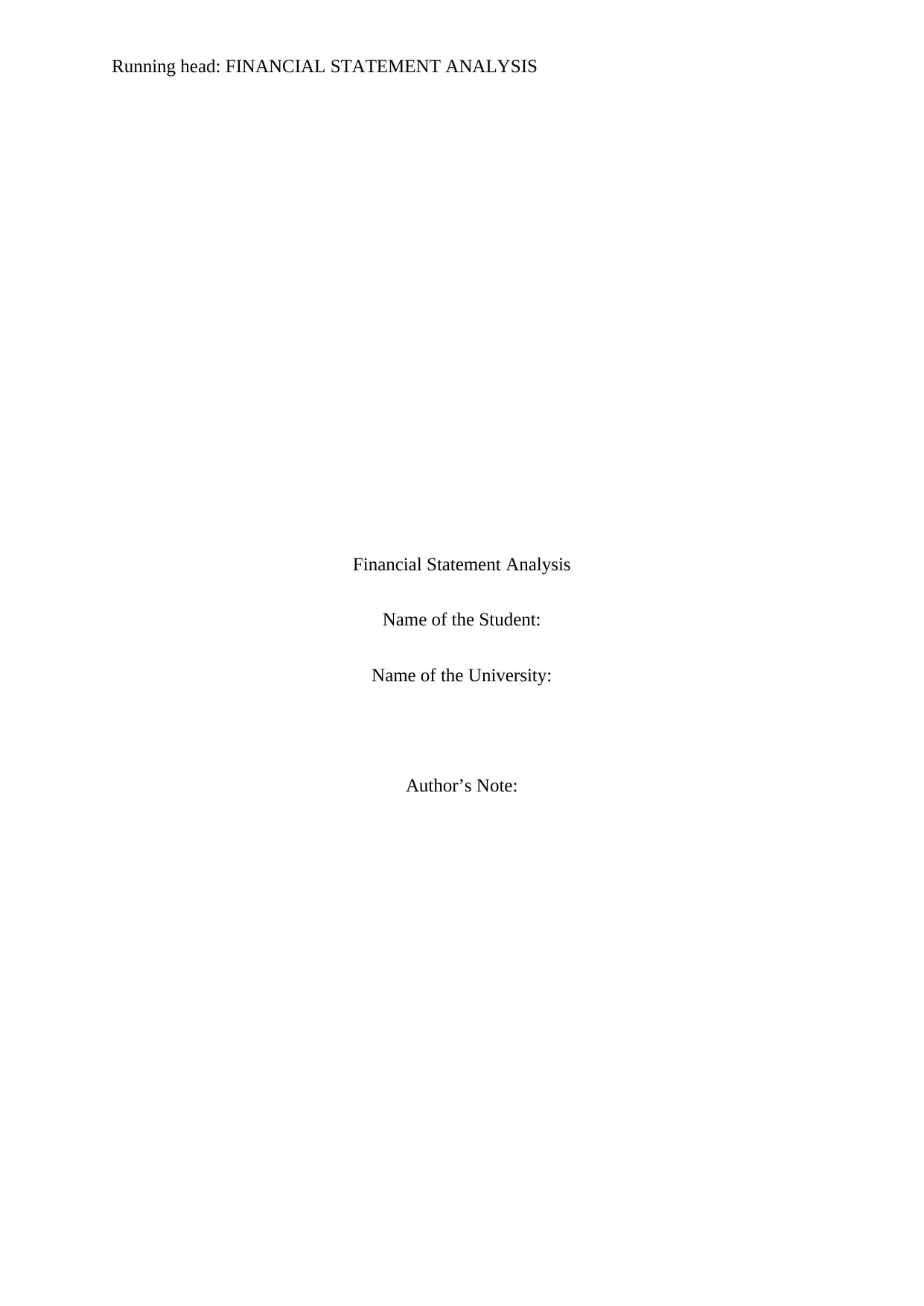
Running head: FINANCIAL STATEMENT ANALYSIS
Financial Statement Analysis
Name of the Student:
Name of the University:
Author’s Note:
Financial Statement Analysis
Name of the Student:
Name of the University:
Author’s Note:
Paraphrase This Document
Need a fresh take? Get an instant paraphrase of this document with our AI Paraphraser
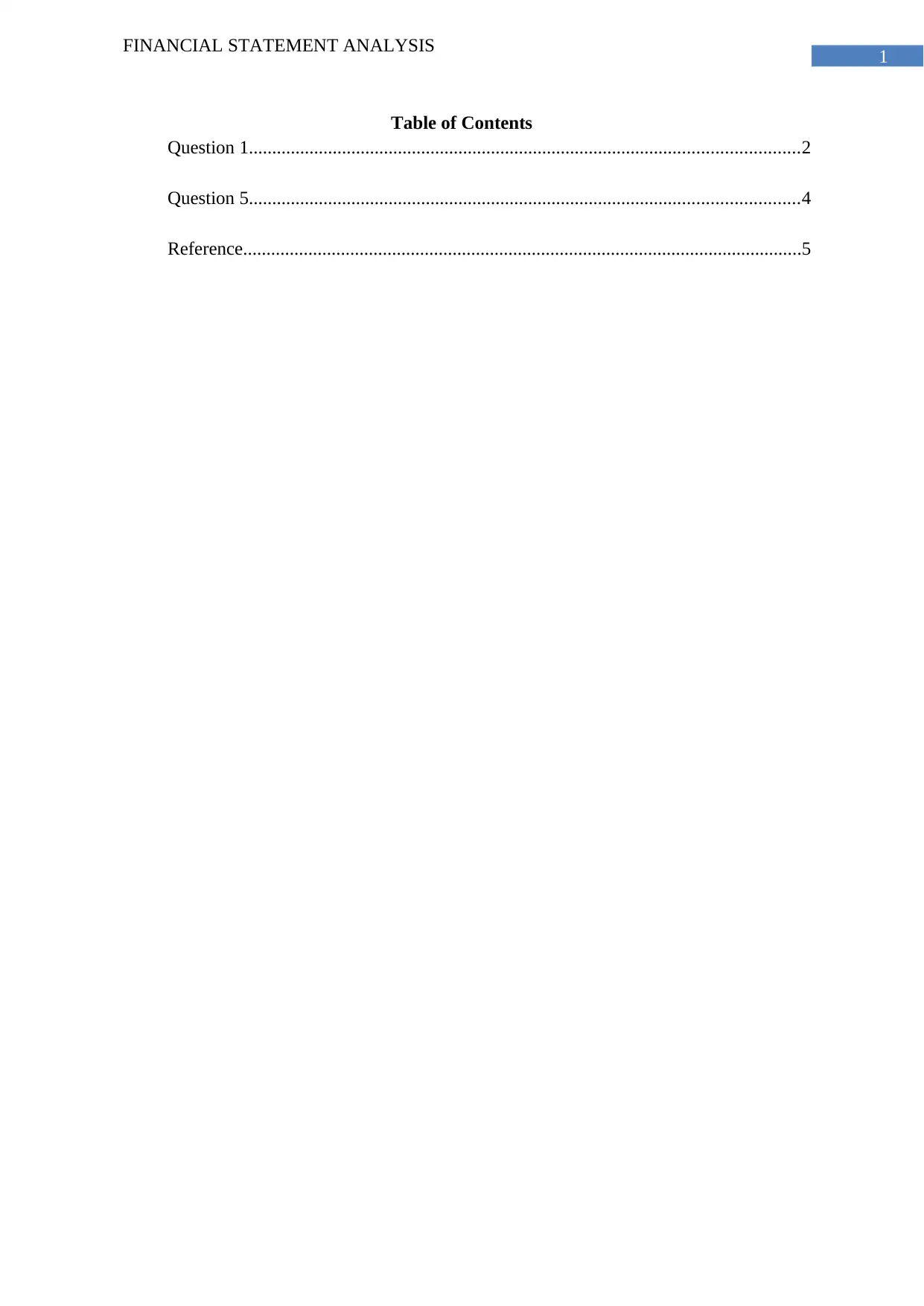
1
FINANCIAL STATEMENT ANALYSIS
Table of Contents
Question 1......................................................................................................................2
Question 5......................................................................................................................4
Reference........................................................................................................................5
FINANCIAL STATEMENT ANALYSIS
Table of Contents
Question 1......................................................................................................................2
Question 5......................................................................................................................4
Reference........................................................................................................................5
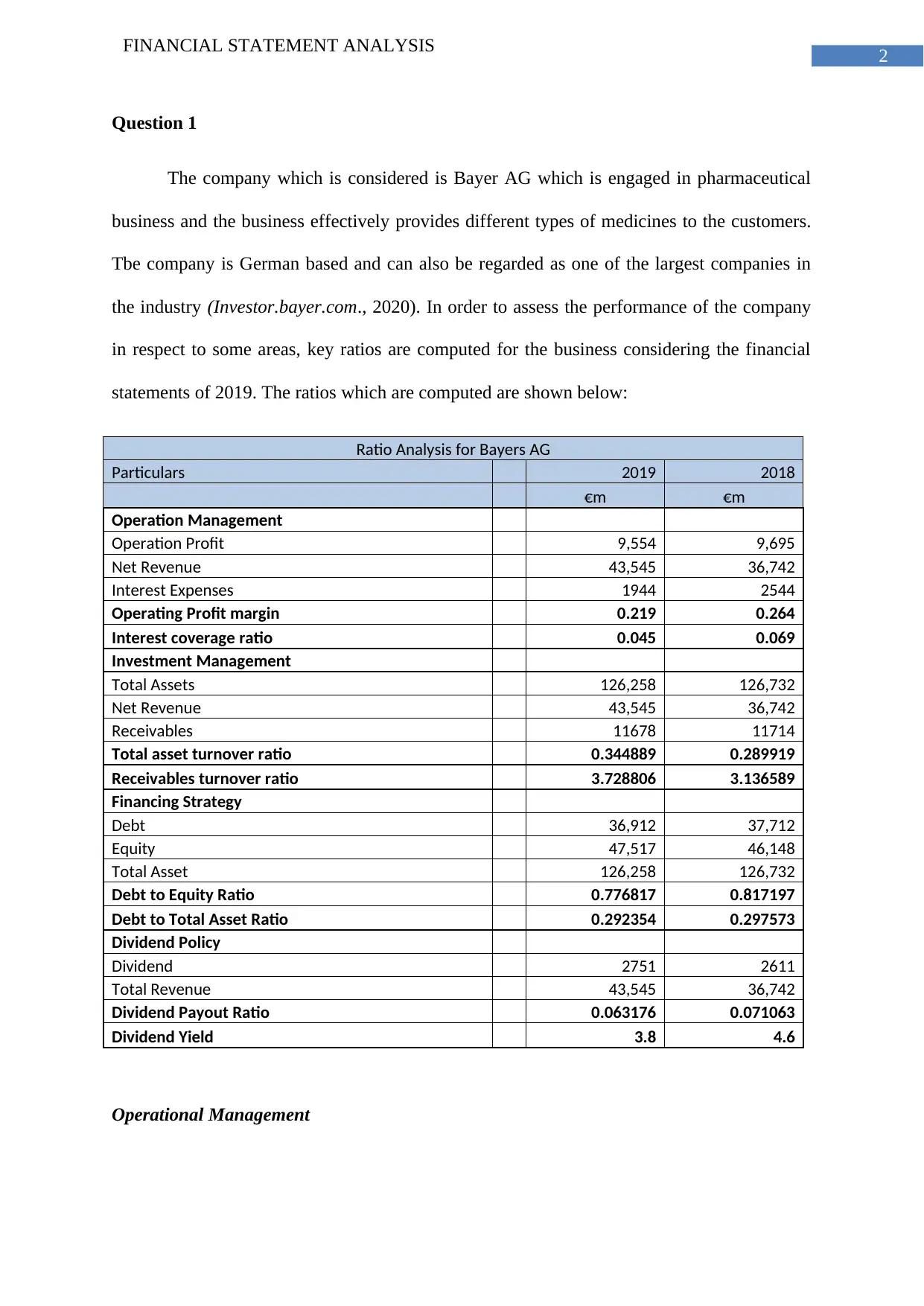
2
FINANCIAL STATEMENT ANALYSIS
Question 1
The company which is considered is Bayer AG which is engaged in pharmaceutical
business and the business effectively provides different types of medicines to the customers.
Tbe company is German based and can also be regarded as one of the largest companies in
the industry (Investor.bayer.com., 2020). In order to assess the performance of the company
in respect to some areas, key ratios are computed for the business considering the financial
statements of 2019. The ratios which are computed are shown below:
Ratio Analysis for Bayers AG
Particulars 2019 2018
€m €m
Operation Management
Operation Profit 9,554 9,695
Net Revenue 43,545 36,742
Interest Expenses 1944 2544
Operating Profit margin 0.219 0.264
Interest coverage ratio 0.045 0.069
Investment Management
Total Assets 126,258 126,732
Net Revenue 43,545 36,742
Receivables 11678 11714
Total asset turnover ratio 0.344889 0.289919
Receivables turnover ratio 3.728806 3.136589
Financing Strategy
Debt 36,912 37,712
Equity 47,517 46,148
Total Asset 126,258 126,732
Debt to Equity Ratio 0.776817 0.817197
Debt to Total Asset Ratio 0.292354 0.297573
Dividend Policy
Dividend 2751 2611
Total Revenue 43,545 36,742
Dividend Payout Ratio 0.063176 0.071063
Dividend Yield 3.8 4.6
Operational Management
FINANCIAL STATEMENT ANALYSIS
Question 1
The company which is considered is Bayer AG which is engaged in pharmaceutical
business and the business effectively provides different types of medicines to the customers.
Tbe company is German based and can also be regarded as one of the largest companies in
the industry (Investor.bayer.com., 2020). In order to assess the performance of the company
in respect to some areas, key ratios are computed for the business considering the financial
statements of 2019. The ratios which are computed are shown below:
Ratio Analysis for Bayers AG
Particulars 2019 2018
€m €m
Operation Management
Operation Profit 9,554 9,695
Net Revenue 43,545 36,742
Interest Expenses 1944 2544
Operating Profit margin 0.219 0.264
Interest coverage ratio 0.045 0.069
Investment Management
Total Assets 126,258 126,732
Net Revenue 43,545 36,742
Receivables 11678 11714
Total asset turnover ratio 0.344889 0.289919
Receivables turnover ratio 3.728806 3.136589
Financing Strategy
Debt 36,912 37,712
Equity 47,517 46,148
Total Asset 126,258 126,732
Debt to Equity Ratio 0.776817 0.817197
Debt to Total Asset Ratio 0.292354 0.297573
Dividend Policy
Dividend 2751 2611
Total Revenue 43,545 36,742
Dividend Payout Ratio 0.063176 0.071063
Dividend Yield 3.8 4.6
Operational Management
⊘ This is a preview!⊘
Do you want full access?
Subscribe today to unlock all pages.

Trusted by 1+ million students worldwide
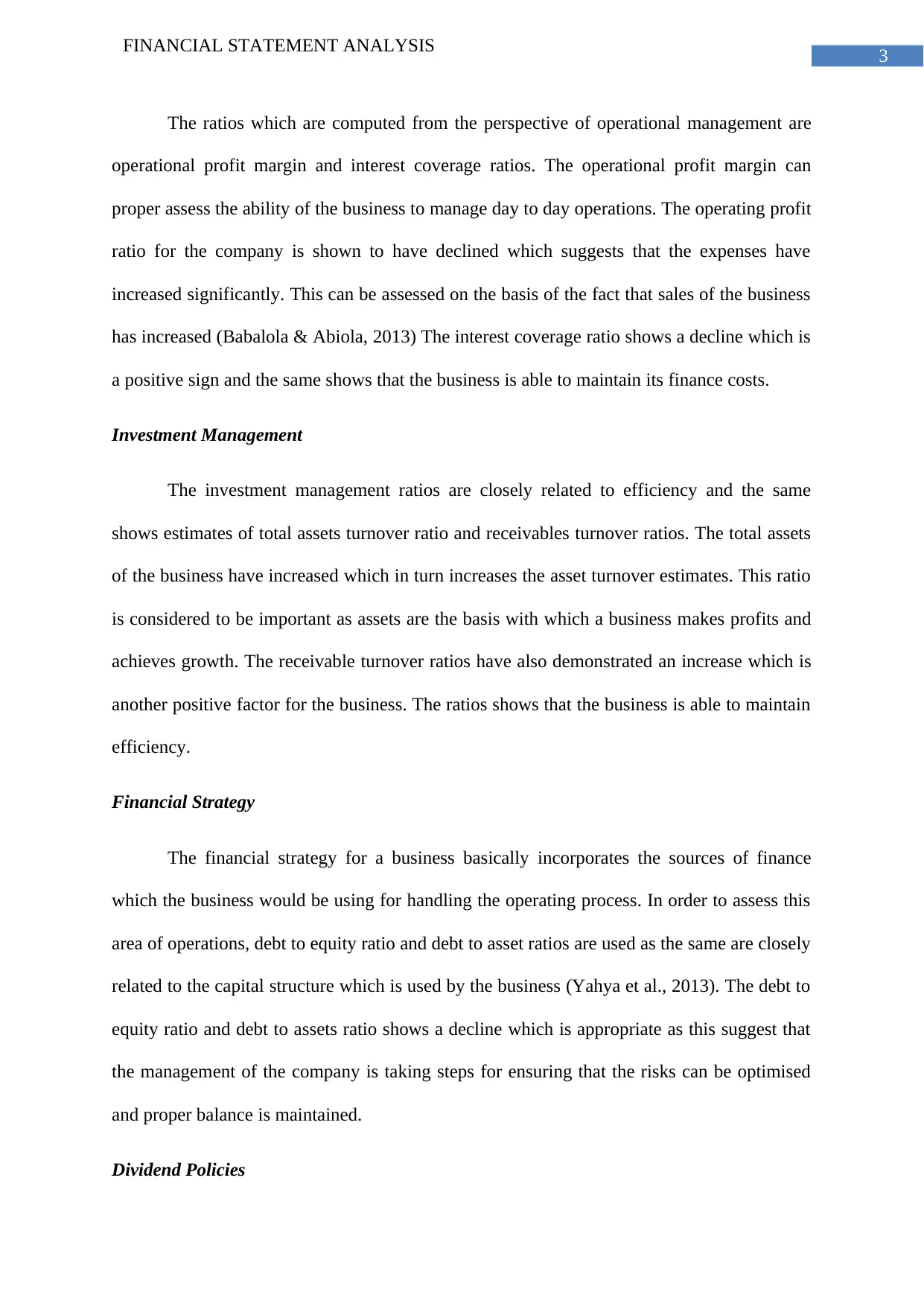
3
FINANCIAL STATEMENT ANALYSIS
The ratios which are computed from the perspective of operational management are
operational profit margin and interest coverage ratios. The operational profit margin can
proper assess the ability of the business to manage day to day operations. The operating profit
ratio for the company is shown to have declined which suggests that the expenses have
increased significantly. This can be assessed on the basis of the fact that sales of the business
has increased (Babalola & Abiola, 2013) The interest coverage ratio shows a decline which is
a positive sign and the same shows that the business is able to maintain its finance costs.
Investment Management
The investment management ratios are closely related to efficiency and the same
shows estimates of total assets turnover ratio and receivables turnover ratios. The total assets
of the business have increased which in turn increases the asset turnover estimates. This ratio
is considered to be important as assets are the basis with which a business makes profits and
achieves growth. The receivable turnover ratios have also demonstrated an increase which is
another positive factor for the business. The ratios shows that the business is able to maintain
efficiency.
Financial Strategy
The financial strategy for a business basically incorporates the sources of finance
which the business would be using for handling the operating process. In order to assess this
area of operations, debt to equity ratio and debt to asset ratios are used as the same are closely
related to the capital structure which is used by the business (Yahya et al., 2013). The debt to
equity ratio and debt to assets ratio shows a decline which is appropriate as this suggest that
the management of the company is taking steps for ensuring that the risks can be optimised
and proper balance is maintained.
Dividend Policies
FINANCIAL STATEMENT ANALYSIS
The ratios which are computed from the perspective of operational management are
operational profit margin and interest coverage ratios. The operational profit margin can
proper assess the ability of the business to manage day to day operations. The operating profit
ratio for the company is shown to have declined which suggests that the expenses have
increased significantly. This can be assessed on the basis of the fact that sales of the business
has increased (Babalola & Abiola, 2013) The interest coverage ratio shows a decline which is
a positive sign and the same shows that the business is able to maintain its finance costs.
Investment Management
The investment management ratios are closely related to efficiency and the same
shows estimates of total assets turnover ratio and receivables turnover ratios. The total assets
of the business have increased which in turn increases the asset turnover estimates. This ratio
is considered to be important as assets are the basis with which a business makes profits and
achieves growth. The receivable turnover ratios have also demonstrated an increase which is
another positive factor for the business. The ratios shows that the business is able to maintain
efficiency.
Financial Strategy
The financial strategy for a business basically incorporates the sources of finance
which the business would be using for handling the operating process. In order to assess this
area of operations, debt to equity ratio and debt to asset ratios are used as the same are closely
related to the capital structure which is used by the business (Yahya et al., 2013). The debt to
equity ratio and debt to assets ratio shows a decline which is appropriate as this suggest that
the management of the company is taking steps for ensuring that the risks can be optimised
and proper balance is maintained.
Dividend Policies
Paraphrase This Document
Need a fresh take? Get an instant paraphrase of this document with our AI Paraphraser
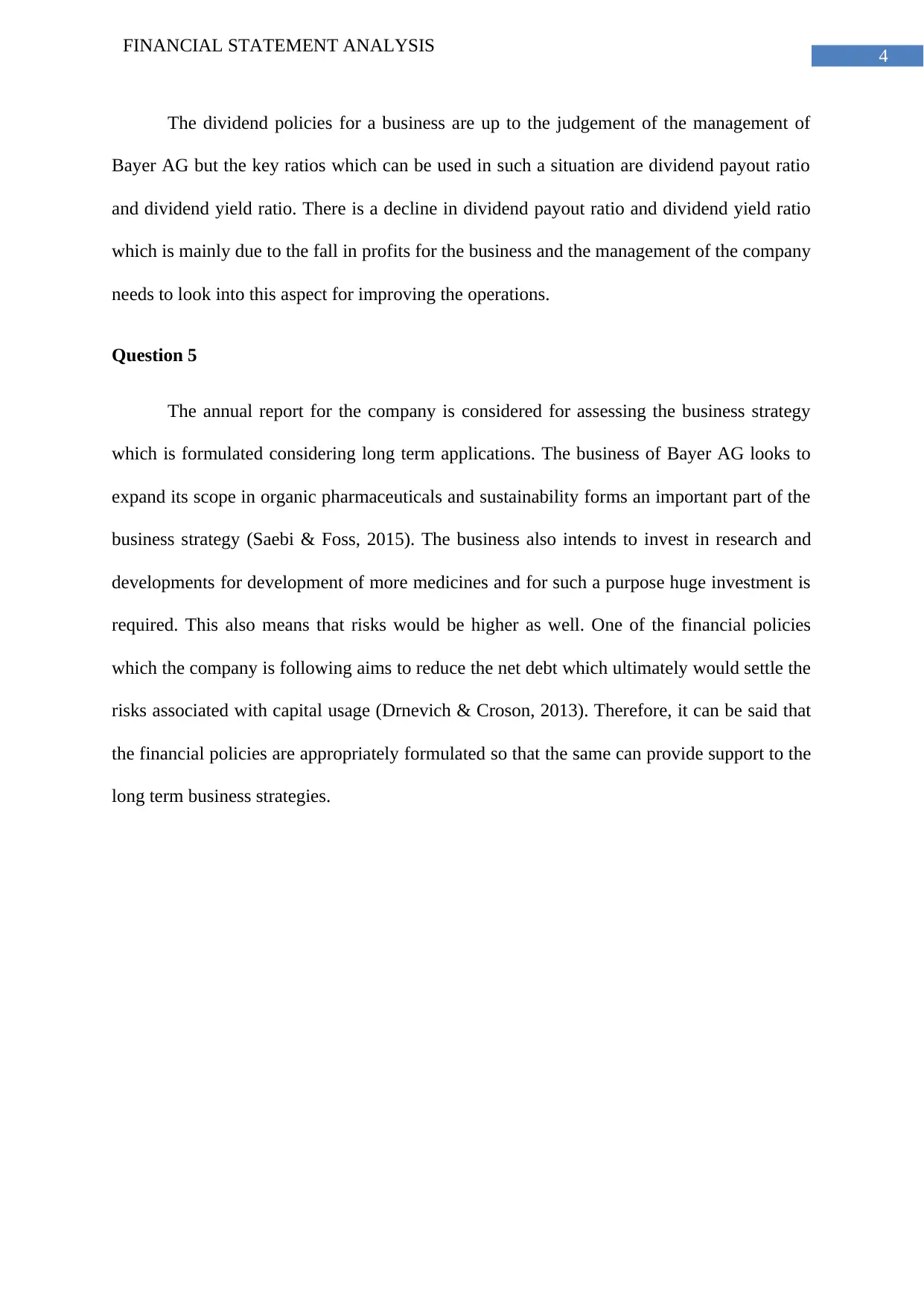
4
FINANCIAL STATEMENT ANALYSIS
The dividend policies for a business are up to the judgement of the management of
Bayer AG but the key ratios which can be used in such a situation are dividend payout ratio
and dividend yield ratio. There is a decline in dividend payout ratio and dividend yield ratio
which is mainly due to the fall in profits for the business and the management of the company
needs to look into this aspect for improving the operations.
Question 5
The annual report for the company is considered for assessing the business strategy
which is formulated considering long term applications. The business of Bayer AG looks to
expand its scope in organic pharmaceuticals and sustainability forms an important part of the
business strategy (Saebi & Foss, 2015). The business also intends to invest in research and
developments for development of more medicines and for such a purpose huge investment is
required. This also means that risks would be higher as well. One of the financial policies
which the company is following aims to reduce the net debt which ultimately would settle the
risks associated with capital usage (Drnevich & Croson, 2013). Therefore, it can be said that
the financial policies are appropriately formulated so that the same can provide support to the
long term business strategies.
FINANCIAL STATEMENT ANALYSIS
The dividend policies for a business are up to the judgement of the management of
Bayer AG but the key ratios which can be used in such a situation are dividend payout ratio
and dividend yield ratio. There is a decline in dividend payout ratio and dividend yield ratio
which is mainly due to the fall in profits for the business and the management of the company
needs to look into this aspect for improving the operations.
Question 5
The annual report for the company is considered for assessing the business strategy
which is formulated considering long term applications. The business of Bayer AG looks to
expand its scope in organic pharmaceuticals and sustainability forms an important part of the
business strategy (Saebi & Foss, 2015). The business also intends to invest in research and
developments for development of more medicines and for such a purpose huge investment is
required. This also means that risks would be higher as well. One of the financial policies
which the company is following aims to reduce the net debt which ultimately would settle the
risks associated with capital usage (Drnevich & Croson, 2013). Therefore, it can be said that
the financial policies are appropriately formulated so that the same can provide support to the
long term business strategies.
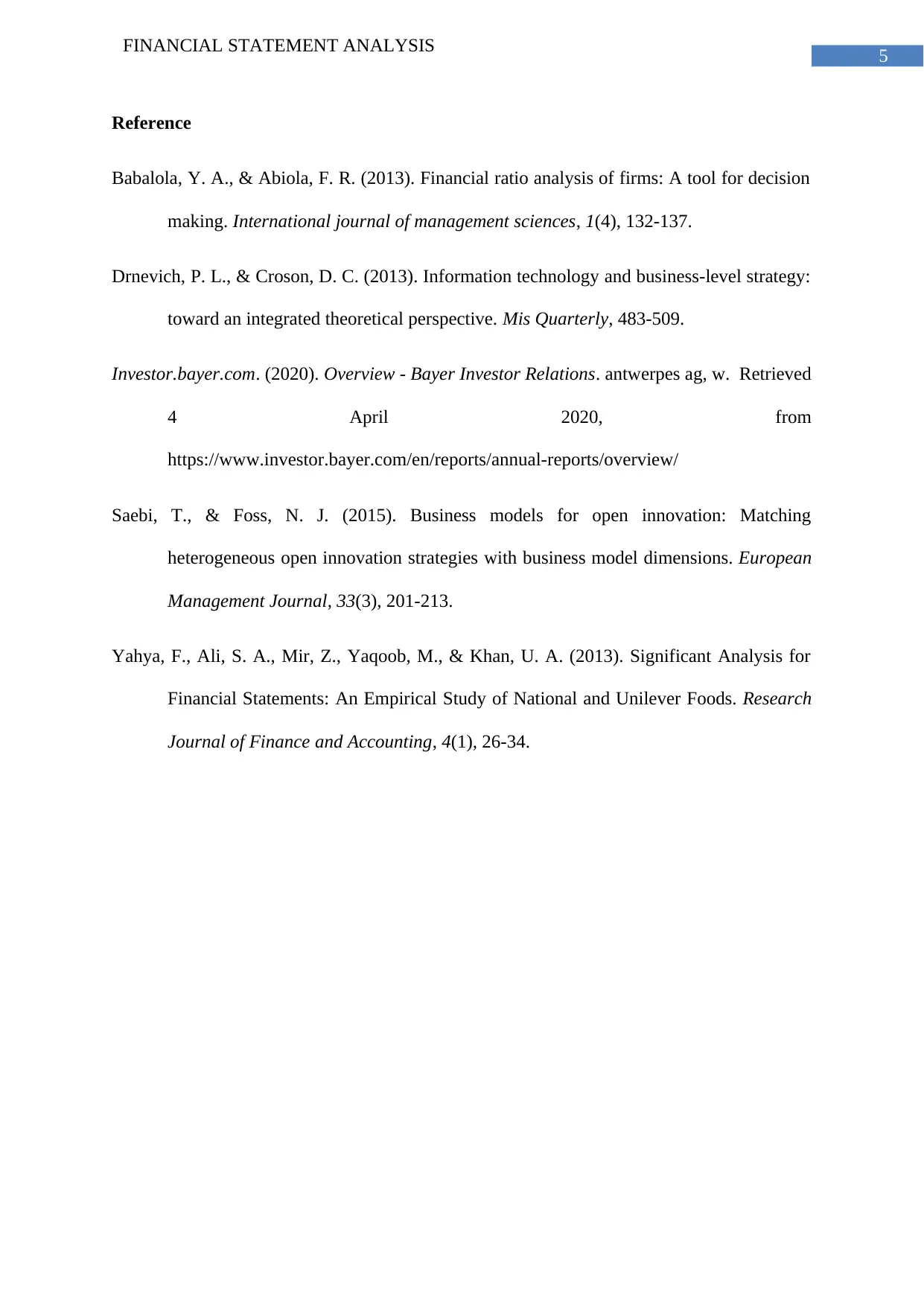
5
FINANCIAL STATEMENT ANALYSIS
Reference
Babalola, Y. A., & Abiola, F. R. (2013). Financial ratio analysis of firms: A tool for decision
making. International journal of management sciences, 1(4), 132-137.
Drnevich, P. L., & Croson, D. C. (2013). Information technology and business-level strategy:
toward an integrated theoretical perspective. Mis Quarterly, 483-509.
Investor.bayer.com. (2020). Overview - Bayer Investor Relations. antwerpes ag, w. Retrieved
4 April 2020, from
https://www.investor.bayer.com/en/reports/annual-reports/overview/
Saebi, T., & Foss, N. J. (2015). Business models for open innovation: Matching
heterogeneous open innovation strategies with business model dimensions. European
Management Journal, 33(3), 201-213.
Yahya, F., Ali, S. A., Mir, Z., Yaqoob, M., & Khan, U. A. (2013). Significant Analysis for
Financial Statements: An Empirical Study of National and Unilever Foods. Research
Journal of Finance and Accounting, 4(1), 26-34.
FINANCIAL STATEMENT ANALYSIS
Reference
Babalola, Y. A., & Abiola, F. R. (2013). Financial ratio analysis of firms: A tool for decision
making. International journal of management sciences, 1(4), 132-137.
Drnevich, P. L., & Croson, D. C. (2013). Information technology and business-level strategy:
toward an integrated theoretical perspective. Mis Quarterly, 483-509.
Investor.bayer.com. (2020). Overview - Bayer Investor Relations. antwerpes ag, w. Retrieved
4 April 2020, from
https://www.investor.bayer.com/en/reports/annual-reports/overview/
Saebi, T., & Foss, N. J. (2015). Business models for open innovation: Matching
heterogeneous open innovation strategies with business model dimensions. European
Management Journal, 33(3), 201-213.
Yahya, F., Ali, S. A., Mir, Z., Yaqoob, M., & Khan, U. A. (2013). Significant Analysis for
Financial Statements: An Empirical Study of National and Unilever Foods. Research
Journal of Finance and Accounting, 4(1), 26-34.
⊘ This is a preview!⊘
Do you want full access?
Subscribe today to unlock all pages.

Trusted by 1+ million students worldwide
1 out of 6
Related Documents
Your All-in-One AI-Powered Toolkit for Academic Success.
+13062052269
info@desklib.com
Available 24*7 on WhatsApp / Email
![[object Object]](/_next/static/media/star-bottom.7253800d.svg)
Unlock your academic potential
Copyright © 2020–2025 A2Z Services. All Rights Reserved. Developed and managed by ZUCOL.





